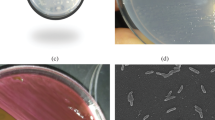Abstract
Dibenzothiophene, a polycyclic aromatic sulfur heterocycle, represents as a model compound the organic sulfur integrated in the macromolecular coal matrix. A pure culture of a Brevibacterium species was isolated, which is able to use dibenzothiophene as sole source of carbon, sulfur and energy for growth. During dibenzothiophene utilization sulfite was released in a stoichiometrical amount and was further oxidized to sulfate. Three metabolites of dibenzothiophene degradation were isolated and identified as dibenzothiophene-5-oxide, dibenzothiophene-5-dioxide and benzoate by cochromatography, UV spectroscopy and gas chromatographymass spectrometry analyses. Based on the identified metabolites a pathway for the degradation of dibenzothiophene by Brevibacterium sp. DO is proposed.
Similar content being viewed by others
Abbreviations
- DBT:
-
dibenzothiophene
- PASH:
-
polycyclic aromatic sulfur heterocycle
- PAH:
-
polycyclic aromatic hydrocarbons
- GC-MS:
-
gas chromatography-mass spectrometry
- HPLC:
-
high pressure liquid chromatography
- IC:
-
ion chromatography
References
Afferdenvan M, Schacht S, Beyer M, Klein J (1988) Microbial desulfurization of dibenzothiophene. Am Chem Soc Div Fuel Chem 33: 561–572
Berthou F, Vignier V (1986) Analyses and fate of dibenzothiophene derivatives in the marine environment. Intern J Environ Anal Chem 27: 81–96
Bos P, Kuenen JG (1989) Microbial treatment of coal. In: Microbial metal recovery, chap 16. McGraw-Hill Book Company (in press)
Boudou JP, Boulegue J, Malechaux L, Nip M, de Leeuw JW, Boon JJ (1987) Identification of some sulphur species in a high organic sulphur coal. Fuel 66: 1558–1569
Catelani D, Sorlini C, Treccani V (1971) The metabolism of biphenyl by Pseudomonas putida. Experientia 27: 1173–1174
Couch GR (1988) Recent progress in coal bioprocessing research in Europe. Resour, Conserv Recycl 1: 207–221
Ensley BDJr (1984) Microbial metabolism of condensed thiophenes. In: Gibson DT (ed) Microbial degradation of organic compounds. Marcel Dekker, Inc. New York, USA, pp 309–317
Foght JM, Westlake DWS (1988) Degradation of polycyclic aromatic hydrocarbons and aromatic heterocycles by a Pseudomonas species. Can J Microbiol 34: 1135–1141
Fortnagel P, Harms H, Wittich RM (1989) Cleavage of dibenzofuran and dibenzodioxin ring systems by a Pseudomonas bacterium. Naturwissenschaften 76: 222–223
Gibson DT, Subramanian V (1984) Microbial degradation of aromatic hydrocarbons. In: Gibson DT (ed) Microbial degradation of organic compounds. Marcel Dekker, Inc, New York, USA, pp 181–252
Gibson DT, Roberts RL, Wells MC, Kobal VM (1973) Oxidation of biphenyl by a Beijerinckia species. Biochem Biophys Res Commun 50: 211–219
Gilman H, Esmay DL (1952) The oxidation of dibenzothiophene and phenoxathin with hydrogen peroxide. J Am Chem Soc 74: 2021–2024
Gundlach ER, Boehm PD, Marchand M, Atlas RM, Ward DM, Wolfe DA (1983) The fate of Amoco Cadiz oil. Science 221: 122–129
Holland HL (1988) Chiral sulfoxidation by biotransformation of organic sulfides. Chem Rev 88: 473–485
Holland HL, Khan SH, Richards D, Riemland E (1986) Biotransformation of polycyclic aromatic compounds by fungi. Xenobiotica 16: 733–741
Hou CT, Laskin AI (1976) Microbial conversion of dibenzothiophene. Dev Ind Microbiol 17: 351–362
Isbister JD, Kobylinski EA (1985) Microbial desulfurization of coal. In: International Conference on Processing and Utilization of High Sulfur Coals, Columbus, Ohio. Elsevier, Amsterdam, NL, pp 627–641
Kargi F, Robinson JM (1984) Microbial oxidation of dibenzothiophene by the thermophilic organism Sulfolobus acidocaldarius. Biotechnol Bioeng 25: 687–690
Kaufman DD, Kearney PC (1976) Microbial transformations in the soil. In: Audus LJ (ed) Herbicides. Academic Press Inc, London, UK, pp 29–64
Kirk KT, Schultz E, Connors WJ, Lorenz LF, Zeikus JG (1978) Influence of culture parameters on lignin metabolism by Phanerochaete chrysosporium. Arch Microbiol 117: 277–285
Klein J, Beyer M, van Afferden M, Hodek W, Pfeifer F, Seewald H, Wolff-Fischer E, Jüntgen H (1988) Coal in biotechnology. In: Rehm H-J, Reed G (eds) Biotechnology, vol 6b. Verlag Chemie, Weinheim, FRG, pp 497–567
Kodama K, Umehara K, Shimizu K, Nakatani S, Minoda Y, Yamada K (1973) Identification of microbial products from dibenzothiophene and its proposed oxidation pathway. Agric Biol Chem 37: 45–50
Krawiec S, Montenecourt BS (1986) Investigation of the potential of Sulfolobus acidocaldarius to transform dibenzothiophene. Final report, DOE/PC/63046: 68p
Laborde AL, Gigson DT (1977) Metabolism of dibenzothiophene by a Beijerinckia species. Appl Environ Microbiol 34: 783–790
Lowry OH, Rosebrough NJ, Farr AL, Randall RJ (1951) Protein measurement with the Folin phenol reagent. J Biol Chem 193: 265–275
Mormile MR, Atlas RM (1988) Mineralization of the dibenzothiophene biodegradation products 3-hydroxy-2-formyl benzothiophene and dibenzothiophene sulfone. Appl Environ Microbiol 54: 3183–3184
Ogata M, Miyake Y (1980) Gas chromatography combined with mass spectrometry for the identification if organic sulfur compounds in shellfish and fish. J Chromatogr Sci 18: 594–605
Pelroy RA, Stewart DL, Tominaga Y, Iwao M, Castle RN, Lee ML (1983) Microbial mutagenicity of 3- and 4-ring polycyclic aromatic sulfur heterocycles. Mut Res 117: 31–40
Pfennig N, Lippert KD (1966) Über das Vitamin B12 Bedürfnis phototropher Schwefelbakterien. Arch Mikrobiol 55: 245–256
Author information
Authors and Affiliations
Rights and permissions
About this article
Cite this article
van Afferden, M., Schacht, S., Klein, J. et al. Degradation of dibenzothiophene by Brevibacterium sp.DO. Arch. Microbiol. 153, 324–328 (1990). https://doi.org/10.1007/BF00249000
Received:
Accepted:
Issue Date:
DOI: https://doi.org/10.1007/BF00249000




